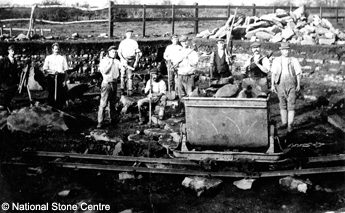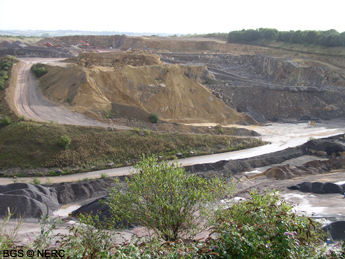
Quarrying: employment and the economy
The quarrying industry, and associated other transport and related service industries have had an important role in the local economy for many years. On a national basis quarrying has traditionally been probably second only to agriculture as a source of rural employment. The industry has been particularly important in the Mendip area since at least 1900. Just after World War I it was seen as an important means of getting ex-servicemen back into work – this being a major factor in the establishment of both Callow Rock Quarry by the Tiark family and the expansion of Dulcote Quarry near Wells by Foster Yeoman.

Detailed studies carried out in 1993 (mainly focussing on the new county of Somerset) calculated that there were 1846 directly and 734 indirectly related jobs dependent upon the industry. At this time, output was 15.3 million tonnes, providing 20% of the areas semi-skilled and unskilled local workforce. This represented 6% of the total employment in Mendip District Council area. Other research at this time put this figure at 2500 – but this probably includes 'downstream' industries such as concrete works. However, the total range of skills is considerable and in 2003 one large employer identified 68 types of jobs associated with the quarry ranging from farm manager to pilot and train drivers. Although the industry is still male dominated, the number of women in senior positions is growing.

The total economic value generated was estimated in the mid 1990s at £150 million of which £40 million went directly into the local economy.
In 1924, some 1824 people were employed in all quarries (plus people working on the surface at mines) in the whole of Somerset. This figure fell in the depression to 1268 in 1934, only to rise rapidly to over 2000 by the onset of the Second World War. The figure fluctuated throughout the 1940s topping 2000 again in the early 1950s. Despite the growing number of operations, mechanisation removed a large proportion of heavy manual tasks so that by the late 1960s even with the considerable increase in output, about 1400 people were employed. Of these over 600 people were actually engaged directly in quarrying, plus 350 in transport and 200 in marketing and administration work. It was estimated that a further 1500 people were involved in other transport and related service industries.
- Home
- Overview maps
- Locality
areas
- Cheddar Gorge
- Charterhouse
- Blackdown
- Burrington Combe
- Shipham & Rowberrow
- Crook Peak & Axbridge
- Banwell to Churchill
- Priddy
- Harptree & Smitham Hill
- Draycott & Westbury-sub-Mendip
- Wookey Hole & Ebbor Gorge
- Wells
- Great Elm & Vallis Vale
- Mells & the Wadbury Valley
- The Vobster area
- The Whatley area
- Torr Works & Asham Wood
- Beacon Hill
- Stoke St Michael & Oakhill
- Holwell & Nunney
- Shepton Mallet & Maesbury
- Gurney Slade & Emborough
- The Nettlebridge valley
- Geology
- Minerals and mines
- Quarrying
- Caves and karst
- Biodiversity
- Detailed site information
- Acknowledgements
- External links
- Search
- Site map